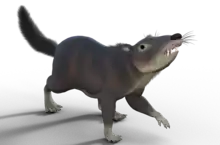Argentoconodon
Argentoconodon (meaning "Argentina cone tooth") is an extinct genus of theriimorph mammal from the Cañadón Asfalto Formation of the Cañadón Asfalto Basin in Patagonia. When originally described, it was known only from a single molariform tooth, which possessed a combination of primitive and derived features. The tooth is currently held in the Museo Paleontológico Egidio Feruglio, where it was given the specimen number MPEF-PV 1877.[2] New material described in 2011 show that Argentoconodon was similar to Ichthyoconodon, Jugulator and Volaticotherium within the family Triconodontidae,[3] and possibly also Triconolestes.[4]
| Argentoconodon | |
|---|---|
| Scientific classification | |
| Kingdom: | Animalia |
| Phylum: | Chordata |
| Class: | Mammalia |
| Order: | †Eutriconodonta |
| Clade: | †Volaticotherini |
| Genus: | †Argentoconodon Rougier et al. 2007 |
| Species: | †A. fariasorum |
| Binomial name | |
| †Argentoconodon fariasorum Rougier et al. 2007 | |
Aerial locomotion
Several postcranial similarities to Volaticotherium suggest that Argentoconodon was capable of gliding. In particular, its femur shares the same shape and proportions as its more complete relative, being highly specialised and without a femoral head, being less competent in rotational movement but more useful in extending the leg and resisting flight stresses.[3]
Argentoconodon's spatio-temporal distribution has been noted as being unusual, in that it is not only a rare Early Jurassic eutriconodont, but also one of the only two South American members of this group, the other being the slightly younger Condorodon; other mammals in the Cañadon Asfalto Formation are various australosphenidans and a putative allothere.[5] This has been considered worthy of interest in the future.[6]
Diet
Like most eutriconodonts Argentoconodon was most likely animalivorous, its molars adapted to shear. In a study detailing Mesozoic mammal diets it ranks among carnivorous species.[7]
References
- http://fossilworks.org/bridge.pl?a=collectionSearch&taxon_no=39760&max_interval=Jurassic&country=Argentina&is_real_user=1&basic=yes&type=view&match_subgenera=1
- Rougier, G.W.; Garrido, A.; Gaetano, L.; Puerta, P.F.; Corbitt, C.; Novacek, M.J. (2007). "First Jurassic Triconodont from South America" (PDF). American Museum Novitates. 17 (3580): 1–17.
- Gaetano, L.C.; Rougier, G.W. (2011). "New materials of Argentoconodon fariasorum (Mammaliaformes, Triconodontidae) from the Jurassic of Argentina and its bearing on triconodont phylogeny". Journal of Vertebrate Paleontology. 31 (4): 829–843. doi:10.1080/02724634.2011.589877.
- A. O. Averianov and A. V. Lopatin. 2011. Phylogeny of Triconodonts and Symmetrodonts and the Origin of Extant Mammals. Doklady Biological Sciences 436:32-35 [M. Uhen/M. Uhen]
- L. C. Gaetano and G. W. Rougier. 2012. First amphilestid from South America: a molariform from the Jurassic Cañadón Asfalto Formation, Patagonia, Argentina. Journal of Mammalian Evolution
- Percy M. Butler; Denise Sigogneau-Russell (2016). “Diversity of triconodonts in the Middle Jurassic of Great Britain” (PDF). Palaeontologia Polonica 67: 35–65. doi:10.4202/pp.2016.67_035.
- David M. Grossnickle, P. David Polly, Mammal disparity decreases during the Cretaceous angiosperm radiation, Published 2 October 2013.DOI: 10.1098/rspb.2013.2110





